Top Rankings
The Capitol Encore Academy School District ranks among the top 20% of public school district in North Carolina for:
Category
Attribute
Diversity
Most diverse schools (Top 1%)
For the 2025 school year, there is 1 public school serving 832 students in The Capitol Encore Academy School District. This district's average testing ranking is 3/10, which is in the bottom 50% of public schools in North Carolina.
Public School in The Capitol Encore Academy School District have an average math proficiency score of 32% (versus the North Carolina public school average of 51%), and reading proficiency score of 41% (versus the 50% statewide average).
Minority enrollment is 76% of the student body (majority Black), which is more than the North Carolina public school average of 57% (majority Black and Hispanic).
Overview
This School District
This State (NC)
# Schools
1 School
2,764 Schools
# Students
832 Students
1,547,014 Students
# Teachers
54 Teachers
100,085 Teachers
Student : Teacher Ratio
15:1
15:1
District Rank
The Capitol Encore Academy School District, which is ranked within the bottom 50% of all 320 school districts in North Carolina (based off of combined math and reading proficiency testing data) for the 2021-2022 school year.
Overall District Rank
#252 out of 325 school districts
(Bottom 50%)
(Bottom 50%)
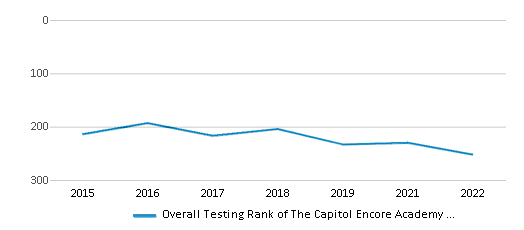
Math Test Scores (% Proficient)
32%
51%
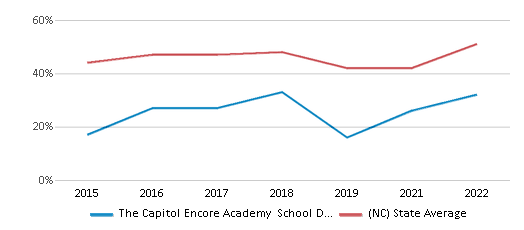
Reading/Language Arts Test Scores (% Proficient)
41%
50%
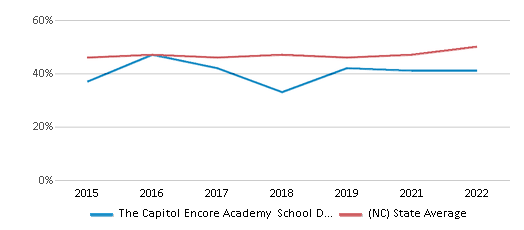
Science Test Scores (% Proficient)
55-59%
63%
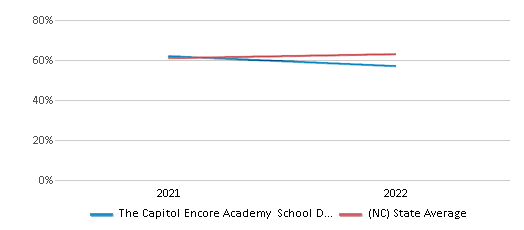
Students by Ethnicity:
Diversity Score
0.72
0.71
# American Indian Students
6 Students
16,971 Students
% American Indian Students
1%
1%
# Asian Students
3 Students
65,132 Students
% Asian Students
n/a
4%
# Hispanic Students
164 Students
326,941 Students
% Hispanic Students
20%
21%
# Black Students
350 Students
380,120 Students
% Black Students
42%
25%
# White Students
199 Students
665,292 Students
% White Students
24%
43%
# Hawaiian Students
2 Students
2,147 Students
% Hawaiian Students
n/a
n/a
# Two or more races Students
108 Students
92,182 Students
% of Two or more races Students
13%
6%
Students by Grade:
# Students in PK Grade:
-
23,648
# Students in K Grade:
80
110,403
# Students in 1st Grade:
71
114,331
# Students in 2nd Grade:
84
118,121
# Students in 3rd Grade:
59
111,941
# Students in 4th Grade:
76
114,493
# Students in 5th Grade:
86
115,565
# Students in 6th Grade:
92
116,023
# Students in 7th Grade:
97
116,793
# Students in 8th Grade:
72
119,029
# Students in 9th Grade:
51
137,977
# Students in 10th Grade:
41
126,349
# Students in 11th Grade:
18
117,582
# Students in 12th Grade:
5
104,759
# Ungraded Students:
-
-
District Revenue and Spending
The revenue/student of $5,642 in this school district is less than the state median of $11,187. The school district revenue/student has declined by 33% over four school years.
The school district's spending/student of $5,544 is less than the state median of $11,612. The school district spending/student has declined by 33% over four school years.
Total Revenue
$5 MM
$17,307 MM
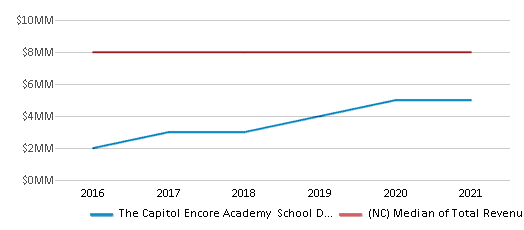
Spending
$5 MM
$17,964 MM
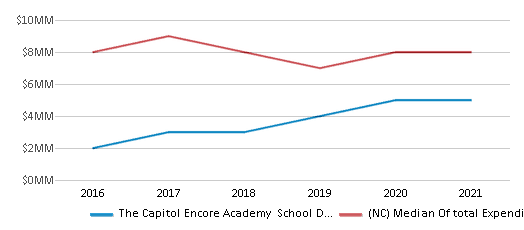
Revenue / Student
$5,642
$11,187
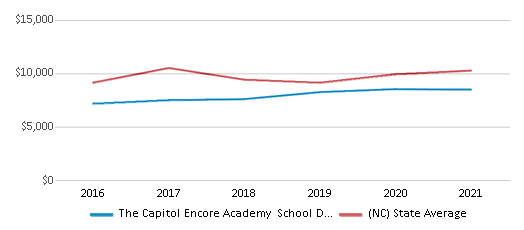
Spending / Student
$5,544
$11,612
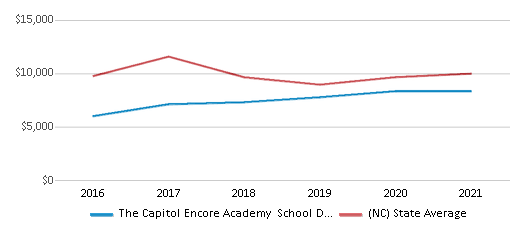
Best The Capitol Encore Academy School District Public Schools (2025)
School
(Math and Reading Proficiency)
(Math and Reading Proficiency)
Location
Grades
Students
Rank: #11.
The Capitol Encore Academy
Charter School
(Math: 32% | Reading: 41%)
Rank:
Rank:
3/
Bottom 50%10
126 Hay Street
Fayetteville, NC 28301
(910) 849-0888
Fayetteville, NC 28301
(910) 849-0888
Grades: K-12
| 832 students
Frequently Asked Questions
How many schools belong to The Capitol Encore Academy School District?
The Capitol Encore Academy School District manages 1 public schools serving 832 students.
What is the rank of The Capitol Encore Academy School District?
The Capitol Encore Academy School District is ranked #253 out of 320 school districts in North Carolina (bottom 50%) based off of combined math and reading proficiency testing data for the 2021-2022 school year. This district ranks in the top 20% of North Carolina school districts for: Most diverse schools (Top 1%)
What is the racial composition of students in The Capitol Encore Academy School District?
42% of The Capitol Encore Academy School District students are Black, 24% of students are White, 20% of students are Hispanic, 13% of students are Two or more races, and 1% of students are American Indian.
What is the student/teacher ratio of The Capitol Encore Academy School District?
The Capitol Encore Academy School District has a student/teacher ratio of 15:1, which is equal to the North Carolina state average of 15:1.
What is The Capitol Encore Academy School District's spending/student ratio?
The school district's spending/student of $5,544 is less than the state median of $11,612. The school district spending/student has declined by 33% over four school years.
Recent Articles

Sexual Harassment at Age 6: The Tale of a First Grade Suspension
A six-year old in Aurora, Colorado, was suspended after singing an LMFAO song to a little girl in his class and reportedly “shaking his booty.” We look at the case and the sexual harassment problem in public schools today.

How Scaffolding Could Change the Way Your Child Learns
This article explores the concept of instructional scaffolding, a teaching method that enhances learning by breaking down complex tasks into manageable parts. It highlights how scaffolding supports students in developing critical thinking skills and becoming more independent learners. The article discusses the benefits of scaffolding, including improved engagement and reduced anxiety, and provides strategies for its implementation across various educational levels.

February 05, 2025
Understanding the U.S. Department of Education: Structure, Impact, and EvolutionWe explore how the Department of Education shapes American education, from its cabinet-level leadership to its impact on millions of students, written for general audiences seeking clarity on this vital institution.





